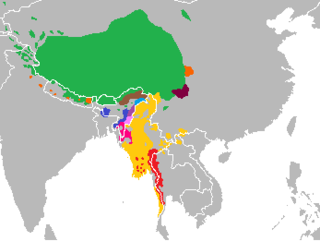| Blimaw | |
|---|---|
| Native to | Myanmar |
Sino-Tibetan
| |
| Language codes | |
| ISO 639-3 | – |
Blimaw is a Karenic language of Myanmar. [1]
| Blimaw | |
|---|---|
| Native to | Myanmar |
Sino-Tibetan
| |
| Language codes | |
| ISO 639-3 | – |
Blimaw is a Karenic language of Myanmar. [1]
Blimaw is classified within the Western Bwe subgroup by Luangthongkum (2019) and is hence closely related to Bwe and Geba. [2] Like Geba, Blimaw preserves the implosives or preglottalised obstruents ɓ/ʔb and ɗ/ʔd, as well as voiceless sonorants such as hn/n̥, hl/l̥, and so forth (see Proto-Karenic language ).

The Karenni, also known as the Kayah or Kayah Li, are a Karen people native to the Kayah State of Myanmar (Burma).

The Karen or Karenic languages are tonal languages spoken by some 4.5 million Karen people. They are of unclear affiliation within the Sino-Tibetan languages. The Karen languages are written using the Karen script. The three main branches are Sgaw, Pwo and Pa'O. Karenni and Kayan are a branch of Karen languages. They are unusual among the Sino-Tibetan languages in having a subject–verb–object word order; other than Karen, Bai and the Chinese languages, Sino-Tibetan languages have a subject–object–verb order. This is likely due to influence from neighboring Mon and Tai languages.

The Tibeto-Burman languages are the non-Sinitic members of the Sino-Tibetan language family, over 400 of which are spoken throughout the Southeast Asian Massif ("Zomia") as well as parts of East Asia and South Asia. Around 60 million people speak Tibeto-Burman languages. The name derives from the most widely spoken of these languages, Burmese and the Tibetic languages, which also have extensive literary traditions, dating from the 12th and 7th centuries respectively. Most of the other languages are spoken by much smaller communities, and many of them have not been described in detail.
There have been various classification schemes for Southeast Asian languages.
Proto-Tibeto-Burman is the reconstructed ancestor of the Tibeto-Burman languages, that is, the Sino-Tibetan languages, except for Chinese. An initial reconstruction was produced by Paul K. Benedict and since refined by James Matisoff. Several other researchers argue that the Tibeto-Burman languages sans Chinese do not constitute a monophyletic group within Sino-Tibetan, and therefore that Proto-Tibeto-Burman was the same language as Proto-Sino-Tibetan.
Rawang, also known as Krangku, Kiutze (Qiuze), and Ch’opa, is a Sino-Tibetan language of India and Burma. Rawang has a high degree of internal diversity, and some varieties are not mutually intelligible. Most, however, understand Mutwang (Matwang), the standard dialect, and basis of written Rawang.
Bwe, also known as Bwe Karen and Bghai (Baghi), is a Karen language of Burma. It shares 82 to 100% lexical similarity with Geba Karen language.
Kayan, also known as, Padaung or Padaung Karen) is a Karen language of Burma, spoken by the Kayan people. The Kayan dialects share more than 90% lexical similarity. Padaung is 71% to 76% lexically similar to Lahta.

Palaung or Ta'ang, also known as De'ang, is a Austroasiatic dialect cluster spoken by over half a million people in Burma and neighboring countries. The Palaung people are divided into Palé (Ruching), Rumai, and Shwe, and each of whom have their own language. The Riang languages are reported to be unintelligible or only understood with great difficulty by native speakers of the other Palaung languages.
The Southern Loloish or Southern Ngwi languages, also known as the Hanoish or Hanish languages, constitute a branch of the Loloish languages that includes Akha and Hani.
Danau, also spelled Htanaw or Danaw, is an Austroasiatic language of Myanmar (Burma). It is the most divergent member of the Palaungic branch. According to community estimates (2023), Danau is spoken by about 3,000 people in six villages near Aungban, Kalaw Township, Shan State. Danau was described as a "critically endangered" language in UNESCO's 2010 Atlas of the World’s Languages in Danger.
The Waic languages are spoken in Shan State, Burma, in Northern Thailand, and in Yunnan province, China.
Lahta, or Zayein, is a Karenic language of Burma.
Geko is a Karen language of Burma. Yinbaw is reportedly a variety. Speakers of Geko and Yinbaw are ethnically Kayan, as are speakers of Lahta and Padaung.
Geba, also known as Eastern Bwe, is a Karen language of Burma.
Sila is a Loloish language spoken by 2,000 people in Laos and Vietnam. Sila speakers are an officially recognized group in Vietnam, where they are known as the Si La.
Mruic or Mru–Hkongso is a small group of Sino-Tibetan languages consisting of two languages, Mru and Anu-Hkongso. Their relationship within Sino-Tibetan is unclear.
Tadahiko Shintani is a Japanese linguist and Professor Emeritus of the Tokyo University of Foreign Studies, specializing in the phonology of New Caledonian languages and Southeast Asian languages.
Proto-Karenic or Proto-Karen is the reconstructed ancestor of the Karenic languages.